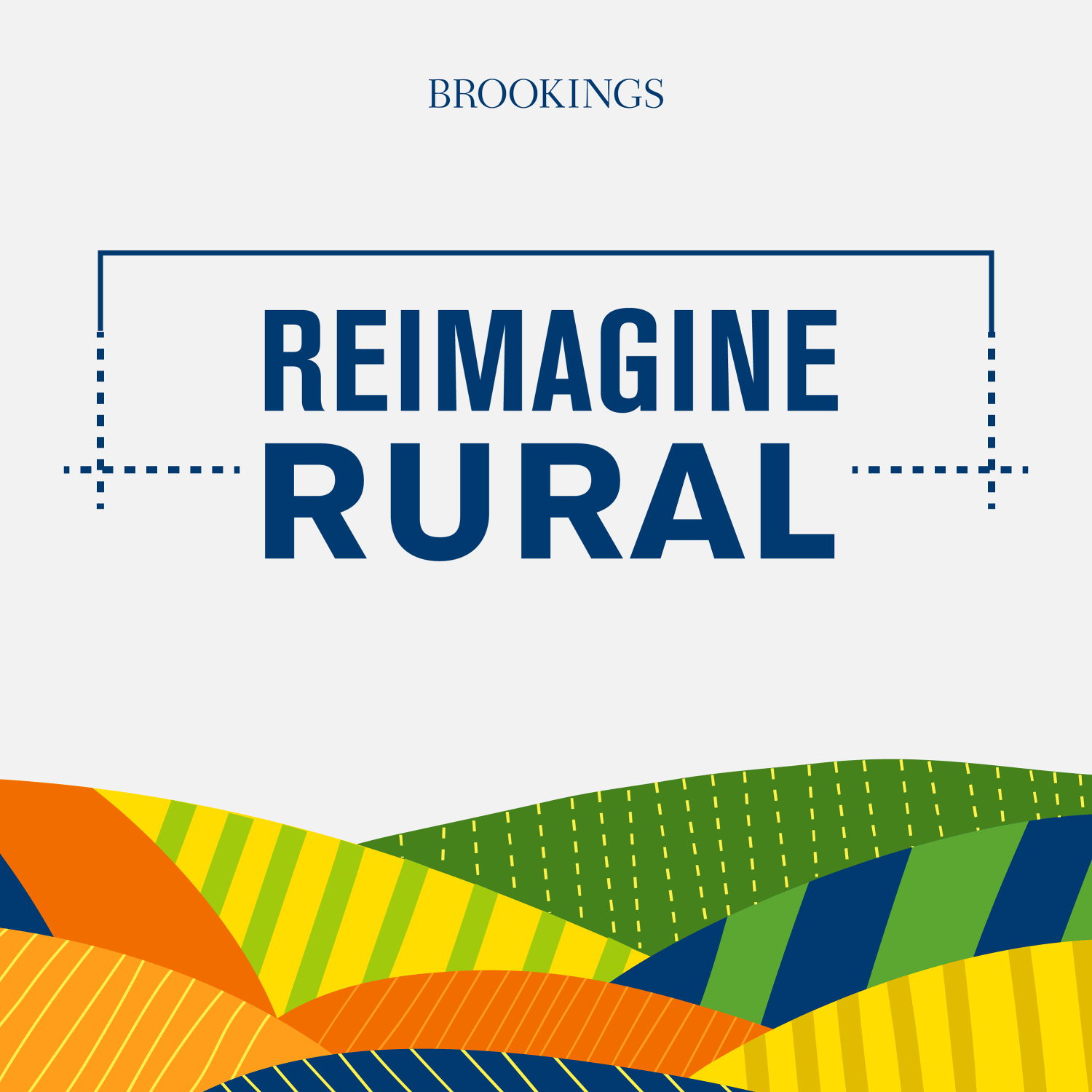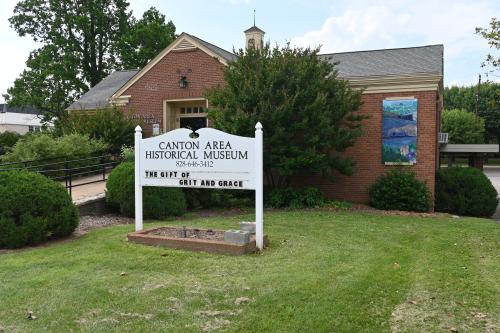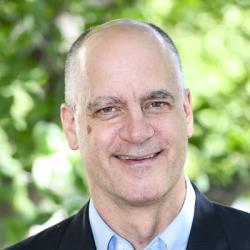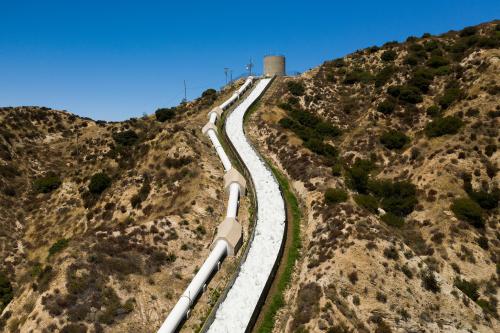In the first two episodes of season three of the Reimagine Rural podcast, Tony Pipa, Senior Fellow at Brookings’ Center for Sustainable Development, explores how two rural communities in western North Carolina, Old Fort and Canton, are recovering from Hurricane Helene—the most devastating storm in state history. To understand the policy implications more deeply, he talked with Matt Calabria, director of the Governor’s Recovery Office for Western North Carolina (GROW NC), who is leading efforts to coordinate the state’s response and support these communities as they navigate their recovery.
This conversation has been lightly edited for clarity and brevity.
How does your office help facilitate the recovery from Hurricane Helene?
Tony Pipa (TP): Matt, thank you for speaking with me today. To get started, can you tell us about the governor’s recovery office? Why was it created, and where does it fit within the state government?
Matt Calabria (MC): Governor Josh Stein created GROW NC on his first full day in office to coordinate agencies, accelerate recovery, and maximize funding for an efficient process in western North Carolina after Hurricane Helene.
My office is situated inside the governor’s office. That was intentional, because we want the work to be done by those best suited to it. You want the State Department of Transportation building and repairing roads. You want the Department of Environmental Quality working on water and resilience issues.
It made sense to have a centralized nerve center, a hub that had a lot of visibility for the governor to look across all agencies and identify gaps and overlaps, and make sure that we mitigate problems that can arise with such complex operations.
TP: How does your role intersect with the federal government?
MC: We interact with the federal government on a daily basis, including with the Federal Emergency Management Agency (FEMA). Just this morning I did a briefing for federal congressional staff, which I do every other week.
A lot of our work is making sure that we are syncing as best we can with the operations of the federal government, which are substantial here in western North Carolina. We often advocate on behalf of the state to various federal agencies or the White House or whomever. We work very closely with our congressional delegation to make sure that we’re putting our best foot forward when it comes to advocating for western North Carolina.
What is the scale and scope of the impact and recovery in western NC?
TP: It’s now been 10 months since Hurricane Helene. Can you give us a sense of the scale and the scope of the damage in western North Carolina, and the status of the state’s recovery?
MC: Hurricane Helene was the worst storm in North Carolina history by a factor of three. If you look at the total dollar amount of damage, we estimate that we’ve incurred about $60 billion in damage. Most acutely, 108 people lost their lives.
The hurricane impacted every aspect of people’s lives, whether it be their jobs, their homes, their ability to move around, their ability to make a phone call, or access their e-mail. So, the recovery effort needs to touch on every aspect of life, as we get physical infrastructure up and running, help folks rebuild their businesses, provide economic support, and rebuild homes.
Western North Carolina is unique because of its topography. One of the things I often say is that never has such a significant storm hit such a mountainous region in the United States. That has created a number of unique or unusual issues, because many people access their homes or their communities through private roads and bridges that were damaged. We saw the need to establish a separate program just to better address those issues.
It really is an all-hands-on-deck effort to make sure that we look at all aspects of people’s lives as they work to recover.
TP: Do you have a timeline for full recovery? How long do you think this might take?
MC: One of the things that’s very tough about disaster recovery is that it’s hard to navigate through disparate expectations. Some folks may think things should move faster. Some folks have an expectation that things will take even longer.
We always try to root our expectations in our peers and our past—to when similar situations have arisen. We know it’s going to be a years-long effort—some aspects are very likely to continue four, five, maybe even six years from now.
Some things are on a shorter timeline. One of the most immediate things is removing debris from the ground, waterways, streets, and people’s yards. That’s a mission that we really focus on. We’re looking to see substantial completion by the end of the first year after the storm.
The things that tend to take the longest usually are home rebuilding and repair efforts, certain major complex infrastructure projects, and roadway projects. Those can be more unpredictable and take longer.
What kind of assistance do rural communities such as Canton and Old Fort need?
TP: Our episodes tell the stories of Canton and Old Fort. How is your office working with those communities?
MC: GROW NC has folks stationed here in the state capital in Raleigh, but we have a roughly equal number stationed in western North Carolina, and their job is multifaceted. They are working out of their cars, going from community to community, providing that connective tissue. They are troubleshooting. They are informing local leaders about the availability of one program or another. They’re making sure that federal funds are getting out in a rapid fashion wherever possible.
One of the big things that we do is say, OK, look, this FEMA reimbursement for this town appears to be hung up. Why is that? Is it because that town didn’t submit a form that FEMA says they have to submit? Or is it because FEMA’s gotten everything, and for whatever reason, they just haven’t gotten around to disbursing funds?
So much of our work is understanding the needs of the community and making decisions about what scarce resources should be applied, and that includes a lot of federal funding. So when we, for example, talk about the Housing and Urban Development’s (HUD) Community Development Block Grant Disaster Recovery (CDBG-DR) program and the more than $1 billion that the state already expects to see from that program, we hear from the community, we understand the needs and say, “OK, we’re going to use this much for single family housing, this much for multifamily housing, this much to get core infrastructure back online.”
So, it’s everything from identifying what major programs and efforts we want to pursue to troubleshooting these issues on behalf of our constituents.
TP: I often hear about real capacity constraints in rural places, where one person might be juggling multiple roles, and local governments have limited staff. From your perspective, how do these constraints affect the recovery process, and how are you helping address them?
MC: The limits are real and significant. Of the 114 municipalities in the affected region, a significant percentage of them do not have a full-time paid town manager. Those that do, even the larger municipalities, have workforces displaced by the storm. Not only are they dealing with an incomplete workforce, but the workforce was also probably lean to begin with.
Now they have outsized demands because of the recovery. That means planning and zoning and building permits and environmental reviews, never mind the constituent calls that arise. On top of that, when you’ve got damaged homes and properties, there are huge question marks when it comes to your property tax base. You have uncertain personnel, uncertain circumstances, outsized demands, and who knows what your budget looks like. That’s difficult. You’ve got to put together your annual budget to make things balanced, and that can be difficult even in non-disaster times when you have a sizable staff.
We’ve really focused on building a strong technical assistance apparatus. The North Carolina League of Municipalities, the Association of County Commissioners, the Councils of Governments, the UNC School of Government, and other associations that we’ve been working with are building a coordinated technical assistance system.
One of the early things that we did was distribute money so they could amp up their technical assistance apparati, and that could mean hiring consultants who help with planning, zoning, building, or legal issues. So much of what we hear is, “Look, we know what we need to do; we just don’t have the people to do it.” We’re continuing to try to bring folks who can help in that regard.
Long-term recovery groups in the days following a disaster are so important in providing disaster recovery assistance. These are local folks who provide food assistance, connect people with resources, or help someone who lost their home connect with what they need. All those important functions that too often can get overlooked. What we’ve done is work with philanthropic partners to financially support those long-term recovery groups to make sure that locals are empowered and have the resources, so they don’t worry about raising funds.
We want them really focused on the recovery efforts. Helping build capacity, build this connective tissue, and eliminate these obstacles has been an important part of our work.
What role does the federal government play in recovery efforts, and how is it working?
TP: Can you explain the importance of federal aid in the disaster recovery process?
MC: Federal resources are an essential part of recovery. One thing to keep in mind is that the federal government is always working on disaster recovery somewhere in the country. States aren’t always like that. States may have a disaster of significant magnitude once every two or five years. So, FEMA provides a great deal of technical assistance, resources, and know-how, and can bring non-federal resources to bear.
North Carolina’s entire annual budget is $33 billion. As I mentioned earlier, we have seen from Hurricane Helene alone an estimated $60 billion in damage. So, it’s very difficult for a single state to fully rebuild after a disaster on its own. That gets even more acute when you think about small towns that may have a budget of six figures or a few million dollars, and then they see tens of millions of dollars in infrastructure damage. That really puts them in a spot.
There are a great number of streams of federal funding that can play a tremendous role. It really is a key part of the equation.
TP: We heard mixed feedback about FEMA and the federal response. What’s worked well, and where do you see room for improvement?
MC: By and large, the people that we work with at FEMA and at other federal agencies are hardworking, responsive, and are doing the best that they can to help folks in western North Carolina. FEMA has a broad job that includes debris removal, rebuilding wastewater plants, getting hospitals back online, or getting utilities reconnected. It’s a set of very disparate functions.
It’s important to know that FEMA is not the only agency. The Small Business Administration (SBA), HUD, and many other agencies are involved. The United States Department of Agriculture (USDA) also has a role with respect to agricultural recovery. There is relatively widespread agreement that FEMA and disaster recovery reforms are appropriate.
We have voiced some concerns about the sunsetting of the Building Resilient Infrastructure and Communities (BRIC) program. North Carolina stood to receive more than $200 million. BRIC programs would have built more resilient infrastructure here. We’ve also voiced concerns about delayed FEMA reimbursements. Much of FEMA’s work is reimbursement-based—local governments spend, submit paperwork, and then get reimbursed, which can take a while.
In the national conversation now, given what’s happened in Texas, is the fact that the Secretary of Homeland Security has to sign off on every FEMA disbursement of more than $100,000. That can create a backlog in getting money for local governments that are already cash-strapped. Not having that money to float to your employees can be a real issue.
FEMA’s governing statutes haven’t been substantially updated in quite some time, so there are appropriate systemic reforms. That said, we really do appreciate all the hard work of FEMA in western North Carolina.
Which federal programs is North Carolina relying on for disaster recovery?
TP: What has been the state’s experience with federal recovery resources? What major programs have worked for the state?
MC: One of the difficult aspects of recovery is that there are so many funding streams. They are administered by a great number of departments that all have different requirements, obligations, and processes. It takes a lot just to be able to navigate across all those programs.
Some of these programs, like FEMA, have done a great deal of work to fund and execute our debris removal and rebuilding efforts. We have benefited from nearly half a billion dollars in FEMA’s Individual Assistance program, which goes right to individuals to rebuild their homes, to get personal property back, and to do other qualifying things.
We’ve also seen hundreds of millions of dollars in Small Business Administration loans, which has been significant.
We’re also working quickly to apply for Economic Development Administration (EDA) disaster funds. North Carolina hasn’t really made full use of those EDA funds in the past. So, when the federal government announced that they’re opening up $1.45 billion in EDA funds to qualifying disasters and that most of the programs are first come, first served, we realized we needed to go to local governments and say, “How can we help you develop a project and get it submitted?” because time is of the essence.
The CDBG-DR program is also an important source of funds. It is virtually unheard of for CDBG-DR funds to be released and brought to bear within a year of a disaster. There are all sorts of reviews, requirements, financial certifications, and contracts to be ironed out, and also required public comment periods, before those funds can be released. We want to move as quickly as possible. Among the cohort of qualifying disasters, we were the first to get our application in, so we’re hoping to beat that one-year mark.
How can the federal disaster recovery system improve, especially in rural areas?
TP: President Trump has issued an executive order to review FEMA’s effectiveness and potentially implement reforms, and bipartisan legislation has also been introduced. What are some of the key things you think should change at FEMA?
MC: It’s something that we’ve given quite a bit of thought to. Governor Stein co-chairs the Council of Governors and has been a leading voice on FEMA reform issues.
One thing that would impact local governments a lot is getting more money out faster and relying less on reimbursements. As mentioned earlier, local governments don’t have a lot of spare cash lying around to float excess expenses. Figuring out how to get money out faster with less red tape—that’s one thing that we have identified.
Another is that a lot of FEMA funds go toward temporary repairs. But then there are later federal funds, CDBG-DR among them, that are geared toward more permanent repairs. How can we unify and coordinate efforts so that local governments can have more streamlined access to funds for immediate disaster recovery efforts and long-term repairs?
Also, how do we make sure that we can better sync up the various federal funding streams and their purposes, so local governments don’t have to meet different sets of requirements for each federal program? How do we better sync everything up, so that the funding works together and ultimately becomes less costly if you do it right once?
TP: How can the disaster relief and recovery system better serve rural communities?
MC: We have to keep in mind that rural communities tend to have fewer resources and a harder time accessing available resources as quickly as larger communities. They also run into a great number of issues that may have existed before the disaster, and those tend to compound.
One of the main things that we can do for rural communities is provide streamlined ways to get resources on the ground with fewer required points of contact, so that one person doesn’t have to interface with a dozen agencies as they rebuild.
We can also provide more technical assistance, not just to tell folks what to do, but to help them do it. That involves helping folks with paperwork and approvals and showing them the funding streams available to enable a town to rebuild its downtown.
That means you have an opportunity to build in the way that you always wanted or change some things from how it was in the past. We’ve seen small towns have great ideas for what they want their downtowns to be but need to get those to the right level of crystallization. That kind of technical assistance doesn’t just come in the form of helping folks navigate the paperwork and be aware of the various programs, but how do you do the pre-work? Closing those access gaps is an area where we could do a great deal of good.
-
Acknowledgements and disclosures
Support for this Q&A is provided by Ascendium Education Group. The conclusions and recommendations of any Brookings publication or podcast are solely those of its authors and speakers, and do not reflect the views or policies of the Institution, its management, its other scholars, or its funders. Brookings recognizes that the value it provides is in its absolute commitment to quality, independence, and impact. Activities supported by its donors reflect this commitment.
The Brookings Institution is committed to quality, independence, and impact.
We are supported by a diverse array of funders. In line with our values and policies, each Brookings publication represents the sole views of its author(s).










Commentary
Getting rural recovery from Hurricane Helene right
Policy insights for Reimagine Rural from Matt Calabria, director of the Governor’s Recovery Office for Western North Carolina
July 30, 2025